14 Freaky Sci-Fi And Fantasy Prisons
With sci-fi prison caper Lockout escaping into cinemas this week, we have a look at some other extreme penitentiaries
With sci-fi prison caper Lockout escaping into cinemas this week, we have a look at some other extreme penitentiaries…
Words by: Dave Golder ( DG ) and Jordan Farley ( JF )
1 Magneto’s Plastic Cell
From: X-Men/X2 (2000/2003)
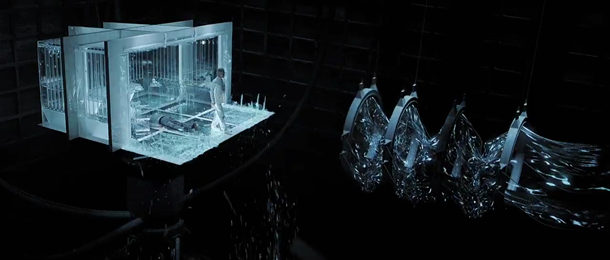
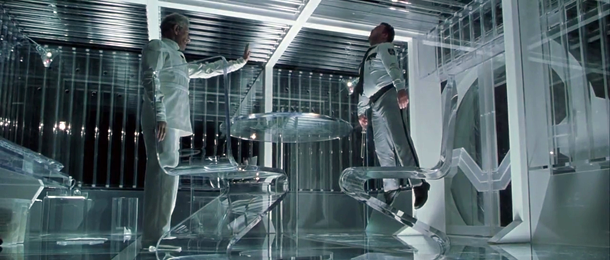
When you have to have a prison especially built for you, you know you’re big league. But else can the authorities do when they want to stop Magneto, Master of Magnetism from escaping, other than build a plastic pen, suspended in a vast void well away from any metal? Not taking any chances, Professor X even has a plastic wheelchair built so he can visit his old mate.
But while the security team presumably made sure none of his visitors had fillings or pacemakers, they didn’t realise that Mystique had secretly injected sneaky amounts of iron into the blood of one of the guards. “Result!” thinks Eric, instantly sensing the contraband mineral, telekinetically ripping it from the guard’s body and turning it into a floating platform and deadly projectiles. DG
2 The Phantom Zone
From: Superman The Movie/Superman 2 (1978/1980)
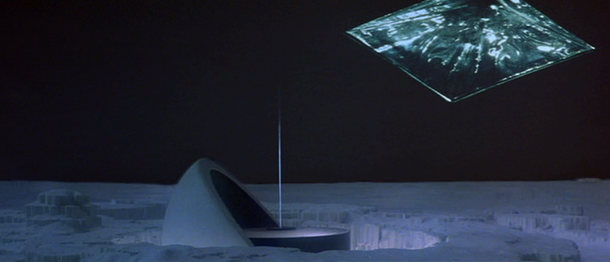
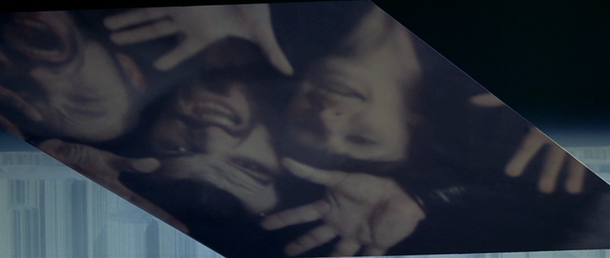
Throughout the Silver Age of comics, the Phantom Zone was officially the worst prison in the universe, if the amount of escapees Superman had to tackle is anything to go by. And Jor-El thought it was such a good idea when he came up with it. Before that convicted Kryptonian crims were put into suspended animation and shot into orbit in capsules, but then Superman’s dad decided that the Phantom Zone was a more humane way of dealing with them. Considering this meant being trapped in a featureless state of existence from which they could only observe, but not interact with, the outside universe, rather than just having a long kip, it’s debatable quite how humane the Phantom Zone truly was. The fact it was cheaper probably had more to do with it.
For Superman The Movie director Richard Donner reimagined the Phantom Zone as seemingly a two-dimensional crystal diamond flipping through space that sucks up Ursa, Non and Zod as it flies by and turns them into a Queen LP cover. And a very impressive and memorable effect it is too, even all these years on. DG
3 Halo Sleep Department Of Containment
From: Minority Report (2002)


Amnesty International might have a thing or two to say about the Halo Sleep detention centre, mainly because none of its inmates has actually committed a crime. In Steven Spielberg’s elegant adaptation (more of an expansion, really) of Philip K Dick’s story, a special PreCrime division of the police arrests people who are going to commit a crime, as predicted by three “Precogs”. It’s a human rights minefield, especially when the whole system is discredited as open to abuse, and all the prisoners are set free.
Get sneak previews, exclusive competitions and details of special events each month!
Or are they?
PreCrime cop John Anderton visits the facility early in the film to find its sentry, Gideon (a man with a set of gnashers clearly designed by Matt Groening) playing Bach on an organ. It’s a lovely piece of visual synergy, because when Gideon takes Anderton into the main chamber where the prisoners are held, they are stored in ranks of gleaming rising-and-falling multi-storey pipes that make the place look like a vast church organ.
The prisoners are held in “halo sleep”, though it’s never made entirely clear what this entails. They are clearly held in some form of cryostatis, but Gideon implies they are not unconscious: “Look at how peaceful they all seem. But on the inside, busy, busy, busy.” Gideon later adds, “It’s actually kind of a rush. They say you have visions. They say your life flashes before your eyes. That all your dreams come true.” So what? They’re reliving their lives? Reliving their crimes? Existing in a virtual world?
That bit about dreams coming true, though… does that mean that everything in the film after Anderton is caught and put into halo sleep – the happy ending – could all be a dream? DG
4 The Waiting Zone
From: Doctor Who “The Happiness Patrol” (1988)

When is a prison not a prison? When it’s a Waiting Zone. Because, of course, there are no prisons on Terra Alpha. Far too miserable for a planet where unhappiness is illegal. The planet instead has Waiting Zone where those being detained are deposited, and the only thing that lets you know you’re in the zone is a stripy line on the floor. So what‘s to keep you there? Ah yeah, the guard with the big gun. But she smiles very nicely at you and looks like she might sell you an ice cream.
The Waiting Zone replaced an actual prison in the script, euphemistically called Arcadia, which was deemed too expensive a set to build for so few scenes. Luckily the very nature of the story meant sticking some tape on the floor of a corner of another set worked just fine in context. DG
5 Fiorina “Fury” 161 Penal Colony
From: Alien 3 (1992)
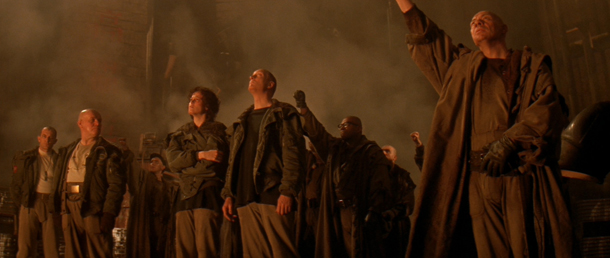
The detention centre in Minority Report may have had ecclesiastical undertones, but the prison in Alien 3 was practically a basilica – a hangover of an early Vincent Ward script set entirely on an interstellar wooden monastery.
What we’re left with isn’t half as unique as a rocket church, but at least penal planet Fiorna 161 is a more interesting place to spend two hours in the company of some (inexplicably) British crims than Strangeways. The “Double-Y” chromosome inmates are free to wander round the facility as they please, and in some cases even chose to stay behind after finishing their sentences and finding religion. It’s dirtier than a coal miner’s bathtub, and nothing seems to work on Fiorna 161. Except the foundry facilities, or course, with the prison also doubling as an iron works – handy when there are no weapons to speak of for xenomorph-hunting anywhere on the planet. One to avoid, even if it’s for a day visit. JF
6 Limbo
From: THX 1138 (1971)

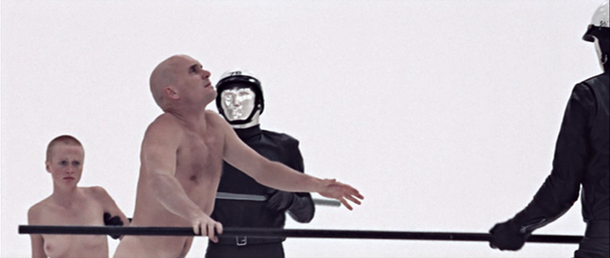
Hell is an eternity stuck in limbo with a bunch of drama students all desperately looking for a Samuel Beckett play to appear in. That’s what THX 1138 (Robert Duvall) discovers when he’s thrown in the film’s all-white limbo. Guarded by steel-faced robots that calmly take a beating from the inmates, this is the easiest prison to escape from on this list. The only reason there isn’t a mass breakout is that most of inmates are obviously complete nutters. It’s a serious flaw in security if you try and imprison someone who isn’t a babbling loon. THX eventually breaks free simply by walking off and finding a door.
A searing indictment of style over substance? A metaphor for a society imprisoned by own inability to move forward? Or a by-product of a cash-strapped debut director who'd seen too many arthouse European movies at college? DG
7 The Cube
From: Cube (1997)
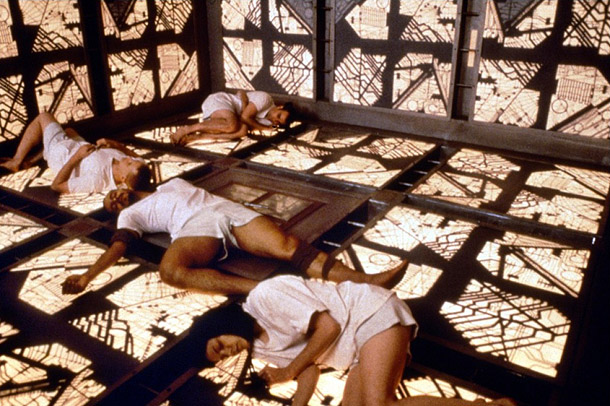
It’s debatable whether the eponymous installation in Vincenzo Natali’s ingeniously cheap debut movie is actually a prison, an alien zoo or some kind of warped experiment. But whether you were a lab rat, a prisoner or a curiosity, you really wouldn’t want to end up trapped there. The place is a death trap, literally. It is constructed from hundreds (possibly thousands) of adjoining cubes, each with six exits (one on each wall, plus floor and ceiling) that lead to identical cubes. Well, almost identical. Not only are they lit differently, but some contain some very nasty surprises, including some slice’n’dice razor wire. (The fact that all the rooms are identical also meant that they only had to build one cube set, and then just light it differently – we said the film was ingenious).
And there’s another really good argument for considering Cube a prison movie: all the characters are named after prisons: Quentin (San Quentin State Prison in California); Holloway (Holloway in London); Kazan (a prison in Tatarstan, Russia); Rennes (a prison in Brittany, France); Alderson (a prison in West Virginia, USA); and Leaven and Worth (a prison in Leavenworth, Kansas, USA). If that isn’t a hint, we don’t know what is. But if your surname’s Parkhurst, start worrying. DG
8 MenTel Maximum Security Prison
From: Fortress (1993)

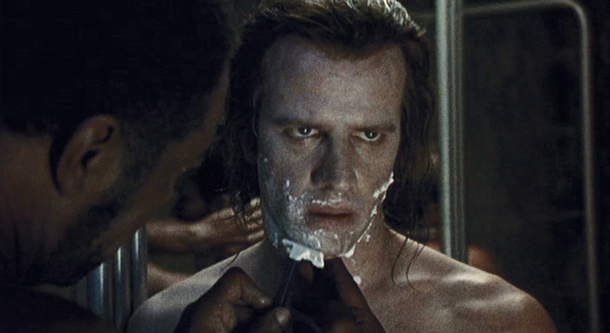
The film that gave us the intestinator, presumably because it has a similar effect to eating a kebab off a van parked outside a nightclub. All the prisoners in MenTel Maximum Security prison in Fortress are fitted with them, and they cause pain or death depending on the severity of an inmate’s transgression. John Henry Brennick (Christopher Lambert) ends up here when he and his wife try to have a second child in a future America where you’re only allowed one baby per couple; because their first child died at birth they gave it another go, then tried to nip across the border to Canada, but were caught.
The intestinator isn’t the only trick used by prison director Poe (Kurtwood Smith) to keep the rowdy inmates under his thumb. The prison itself is located over a deep pit that can only be crossed by a retractable bridge, while the prisoners are kept in overcrowded cells invisible, deadly energy walls. Poe is also quick to mindwipe insubordinates and uses the prison computer, Zed-10, to monitor their dreams. The dirty old git. Bet his YouTube channel has an age gate. DG
9 Camp Holiday
From: Wedlock (1991)
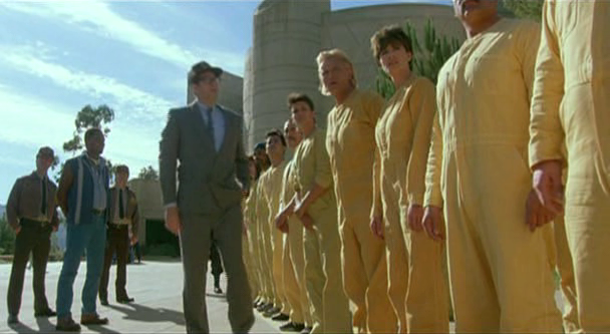
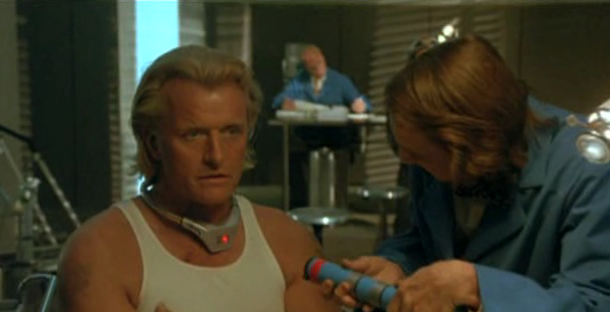
The main security system at the euphemistically-named Camp Holiday looks like an idea dreamt up by some rejected hopeful on Dragon’s Den . Convicted diamond thief Frank Warren (Rutger Hauer) is sent to a prison where all the inmates have to wear special collars, and these future electronic tags have a deadly twist. They come in pairs, and each pair must stay within 100 yards of each other, otherwise both will explode. Trouble is, no prisoner knows who their “wedlock” partner is, making solo escapes impossible. But Frank does manage to find his partner, and what do you know, it’s a woman – Tracey Rigg (Mimi Rogers). So they escape together and from there on in the film is a clever dark comedy satirising the institution of marriage and making deep, insightful comments about monogamous relationships. Or maybe it becomes a silly chase movie. What do you think? DG
10 CryoPrison
From: Demolition Man (1993)
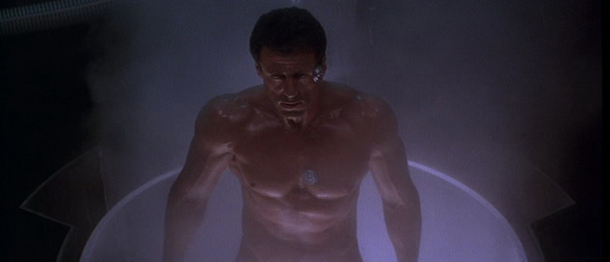
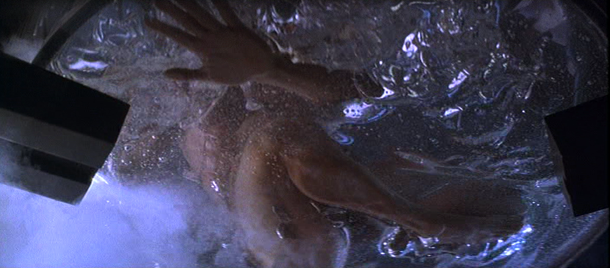
One of those action films that’s a darn sight better than it has any right to be, Demolition Man is blessed with a cheeky sense of humour that marks it out from the crowd. This is, after all, the film in which Sylvester Stallone takes up knitting. And it’s a direct result of his incarceration.
Cop John Spartan (Stallone) is cryogenically frozen for crimes he did not commit, at the same time that his psycho arch-nemesis Simon Phoenix (Wesley Snipes) is cryogenically frozen for crimes that he did. While they’re sleeping, two things happen: society wipes out violent crime and becomes a bit soft, and Spartan and Phoenix are subjected to “rehabilitation” through subconscious suggestion.
When Phoenix escapes during a parole hearing, this peaceful future society had no idea how to deal with him, so they wake up Spartan too, in the hope he knows what to do. But when Spartan wakes up, he discovers that the main new skill he’s acquired from the rehab programme is the purl stitch… DG
11 The Village
From: The Prisoner (1967-8)


Is it a prison? A twisted social experiment? The figment of one man’s shattered psyche? No one really knows. What we do know is that Patrick McGoohan’s definitive ’60s spy-fi show made stunning use of one of the UK’s most unique real world locations (Portmeirion) to create one of sci-fi’s strangest lock ups.
Only the numerical inmates aren’t locked up. Not really. They live in apparent luxury with no visible guards in The Village and no walls surrounding the modern Italianate architecture. This prison’s means of control are much more sinister – bugs, moles, indoctrination and fear keeping its inmates contained within. But when someone does break free of their psychological shackles there’s always impossible incarceration bubble Rover and the surrounding mountain ranges/sea to prevent an escape.
Subterranean tunnels and caverns connect disparate parts of the Village, usually to the advantage of its shadowy overseer, Number Two, while Mini Mokes and helicopters seem to be the most common forms of transport above. It’s a place that exists in no discernible time period, with lava lamps, giant chessboards, penny farthings, credits and omnipresent lift music giving the self-contained society no recognisable identity. At least they do goodbyes well. Be seeing you. JF
12 Azkaban
From: Harry Potter And The Prisoner Of Azkaban (2004)

It’s not so much the prison building of Azkaban itself that makes it a freaky jail (though being a giant Toblerone in the middle of the North Sea isn’t exactly your average state penitentiary either), but rather the guards who patrol the place. Azkaban is a jail for seriously naughty wizards and the only way to keep them in check is use Dementors for security. Dementors, if you didn’t know, are soul suckers, and the large concentration of them at Azkaban renders the inmates incapable of happiness and forces them to relive their worst memories. Gradually they become helpless and often severely insane. It’s a bit like watching ITV3. DG
13 New York
From: Escape From New York (1981)
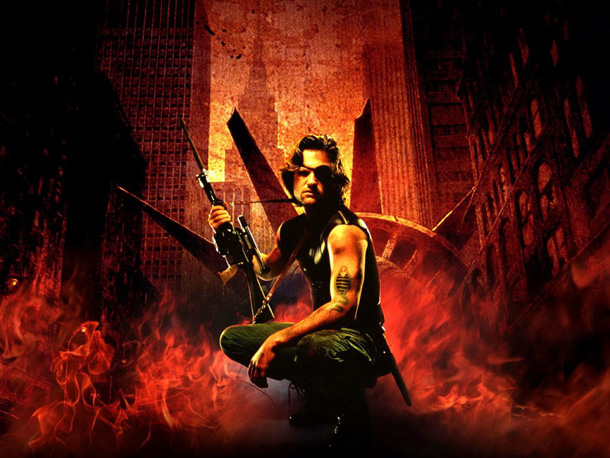
The Big Apple doubles as the Big House in Escape From New York – John Carpenter’s occasionally imitated (see: Lockout ) but never-bettered cult classic (certainly not by his own sequel, Escape From LA ). In the far-flung, ultra-right-wing future America of, er, 1997, New York has been isolated from the rest of the country and given over to its criminal population. The only authority figures are situated safely behind a giant perimeter wall, leaving the inmates to fend for themselves in a brutal kill-or-be-killed fight for survival.
The city has been devastated, but you can still catch the occasional cab, and men such as Isaac Hayes’ Duke live a life of relative luxury at the top of the food chain. With Manhattan being an island the only road in and out is lined with mines and wrecked vehicles, making escape near impossible. Still, it does at least have the honour of a Presidential visit. How many other prisons on this list can say that? JF
14 Crematoria Slam Facility
From: The Chronicles Of Riddick (2004)


Introduced in The Chronicles of Riddick , Crematoria Slam Facility is a sweaty, claustrophobic triple-max prison drilled into the surface of the planet Crematoria, and considered inescapable because of the planet’s extreme climate. It has 52-hour days, with days so hot you would be incinerated in seconds, and nights so cold you’d freeze instantly. However, there is a 20-minute temperate zone between each, which is handy for taking off and landing.
Of course, this wasn’t Riddick’s first time jail. When we first met him in Pitch Black , he had been captured following a jail break, and was en route back to imprisonment. But which prison had he escaped from? It’s not entirely clear.
The animated Pitch Black prequel Slam City (co-written by Pitch Black writer/director David Twohy), he is shown escaping from the Ursa Luna Slam City Facility, a place so dark inmates have to have surgery on their eyes to see there.
However, in the videogame Escape From Butcher Bay , he escapes from a prison called, you guessed it, Butcher Bay. Aaargh! This is the kind of things that leads to schisms in fandom! DG
A few more sci-fi prisons…
Not so freaky but still worth a mention
Shada – the prison planetoid of the Time Lords in the never completed, Douglas Adams scripted Doctor Who story “Shada”.
Rura Penthe – in Star Trek , A frosty Klingon planet most famous for its penal colony, where inmates work in harsh dilithium mines. (It was named after a Siberian penal colony in War and Peace .)
Stormcage Containment Facility – where River Song is held in Doctor Who . Security would improve massively if they employed gay men.
Arkham Asylum – where supervillains escape from in Batman.
Ryker’s island – Marvel’s less gothic version of Arkham Asylum.
Astral Queen – prison ship in Battlestar Galactica (both versions – though not named in the original, the ship design is identical).
Gouffre Martel – a complex of underground caves in the Pyrenees used as a prison in The Stars My Destination.
Salusa Secundus – prison planet in the Dune series.
Dol Guldur – Sauron’s stronghold in Mirkwood in Lord Of The Rings
Dante 01 – cruciform prison ship orbiting the planet Dante in pretentious French movie Dante 01.

Dave is a TV and film journalist who specializes in the science fiction and fantasy genres. He's written books about film posters and post-apocalypses, alongside writing for SFX Magazine for many years.


